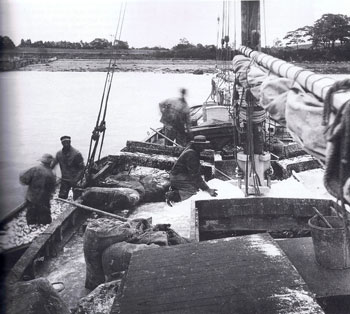B A C K T H E N
Dipping Herring

Photo courtesy of Baldwin Coolidge; Maine Historic Preservation Commission
Castine, possibly 1907. Dipping herring into a schooner-rigged sardine carrier. The fish have been trapped and then seined in the weir, left background, and dipped into dories. The tide is low, and the fish are being brought out to the carrier by the dory-load—a second dory is being unloaded on the port side. The dipnets are shallow-netted hoops, wielded somewhat in the manner of pitchforks, the differences between dry hay and wet herring notwithstanding.
The man kneeling is adding salt to the fish as they slide down the scale-spattered “flume” into the hold. Soaking in brine helped to preserve the fish and was also the first stage of their processing. Burlap sacks on deck hold more salt. “Flume” has a British ring to it—a Mainer might rather have preferred sliding “sluice” off his tongue — and is indicative of the strong hold that New Brunswickers had on the business. Although this little schooner had to have been built on United States soil to freight sardines in American waters, she was likely built and manned by Provincial “herring-chokers,” although an American canner may own some of her.
She may or may not have auxiliary power. Most of the schooners and big sloops built as carriers in the early 1900s were auxiliaries, although at least two, the twins Hazel Leah and Reliance, sixty-one feet on deck, and built at Lubec in 1903, were built with sail only. (About 1906 a three-cylinder Wolverine gas motor was installed in the Hazel Leah, the shaft running to one side of the drift-filled deadwood.) Due to their low freeboard when loaded, carriers commonly ran the exhaust stack up through the after-cabin coachtop, which suffered from occasional charring. No stack is in evidence here, although it may well be right aft of the mast. The white binnacle box held a compass and lantern.
In model and rig, whether sloop or schooner, sardine carriers were unique on the coast. Underwater, even square-sterned boats were double-ended. Designed to be easily driven, they would appear to represent the traditional model of the old Passamaquoddy caraway boat stretched out to carry both an engine and fish. Considerable deadrise combined with slack bilges and narrow beam meant that they were not shy about rolling, particularly when light—wits claimed that some were so tender that if you stepped on the railcap when coming aboard the mast would poke you in the eye! Although the schooners were short-masted and very simply rigged, and were fitted with but a shoe on the keel, they were known as fast and weatherly sailers. In light winds, some of the engineless schooners are said to have set a big club topsail, racing-yacht fashion, from the deck.
With an engine installed, it did not take long for the main boom to be removed, facilitating the construction of a wheelhouse. Later the mainmast was dispensed with, and the carrier became a full motor vessel. The narrow and slippery model was long retained, however, as economical speed was always of the essence.
The 1950s were perhaps the heyday of the sardine carrier. The practice of stop-seining, which brought the net to the fish, rather than depending on the fish to find the weir, meant that carrier skippers had to operate in dark of night and thick of fog in the treacherous waters that other mariners were paid to avoid. Twenty-four hours was as long as the fish could be held aboard a boat without turning to mush, and the factories wanted fish on hand at dawn. Despite such demands, the piloting abilities of these skippers were reflected in their boats’ reportedly having the lowest insurance rates of any fishery-employed vessels on the coast of Maine.
In 1907, the sardine factories closest to Castine were at Deer Isle and Brooklin; presumably this carrier works for one of them. Weirmen attracted the attention of a carrier by means of a signal, such as a hoisted barrel. In 1912, according to the April Industrial Journal, there were sixty-eight weirs in the Bagaduce region.
In later years the scales sticking to the flumes would themselves become valuable for a variety of industrial purposes, including the manufacture of fake pearls. Sardine men of the 1950s still recall that Queen Elizabeth was crowned while wearing a necklace made of sardine scales.
Text by William H. Bunting from A Day’s Work, A Sampler of Historic Maine Photographs, 1860-1920, Part I. Published by Tilbury House Publishers, Gardiner, Maine, 800-582-1899
